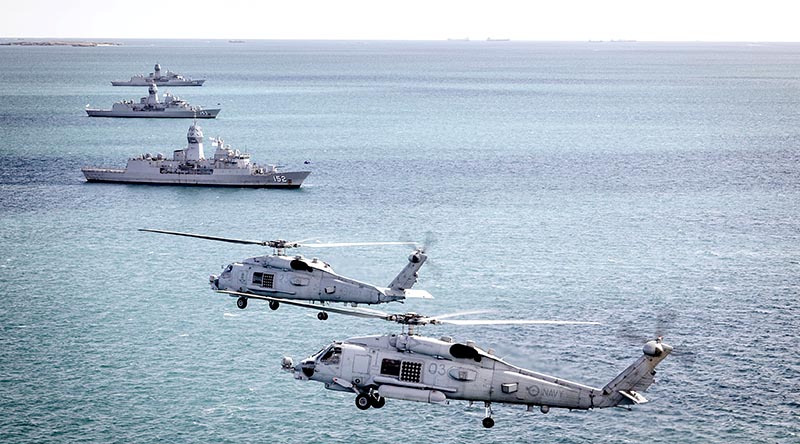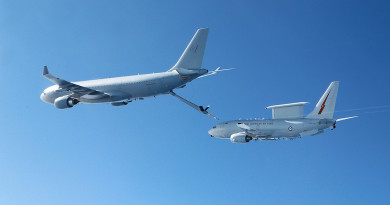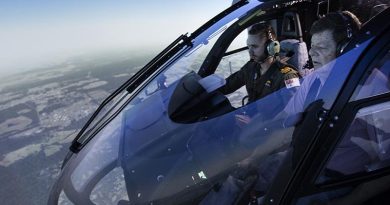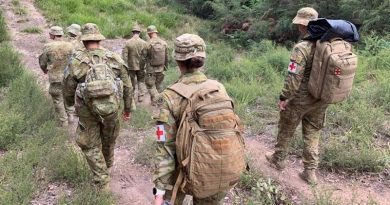Anzac wolf pack hunts subs off WA

Four of Australia’s seven Anzac-class frigates sailed in formation off the Western Australian coast for ASWEX 25 this month.
CAPTION: Two MH-60R Seahawk helicopters circle HMAS Warramunga, HMAS Stuart and HMAS Toowoomba as the ships prepare for ASWEX 25. Story by Lieutenant Marcus Middleton. Photo by Leading Seaman Iggy Roberts.
Their mission – to hunt Australian submarine assets to ensure the Royal Australian Navy is fully capable of protecting Australia and its interests.
While capable of operating independently for long periods, for ASWEX, this lethal grey wolf, the backbone of the fleet, operated in packs.
HMA Ships Warramunga, Toowoomba, Stuart and Arunta worked as one, united frigate force under the direction of the Australian Maritime Task Group.
Joined by HMA Ships Choules and Hobart, the task group fleet put proof to the concept of an agile fleet that is focused, lethal and ready.
In the skies, the fleet was supported by Royal Australian Navy MH-60R helicopters, as well as RAAF and Royal New Zealand Air Force P-8A Poseidon sub hunters, generating a significant force tailored for sea control and deterrence missions.
Commanding Officer Warramunga Commander Dylan Phillips said ASWEX was a significant opportunity to uplift mariner and warfare skills by undertaking complex activities as part of a task group.
“The required coordination added a level of complexity impossible to replicate when operating independently,” Commander Phillips said.
“It was also a great opportunity to train our next generation of Navy personnel, ahead of the introduction of exciting new capabilities including the Hunter-class anti-submarine frigates and general-purpose frigates.”
Anzac-class frigates are highly capable ships, fitted with air and surface surveillance radars, omni-directional hull-mounted sonar and electronic support systems that all interface simultaneously with the 9LV453 Mk3E combat data system to present a coherent tactical picture to the warfare team.
They are also armed with Mark 45 5-inch guns capable of firing 20 rounds per minute, ship-launched MU90 anti-submarine torpedoes and the Mark 41 vertical launch system for the Evolved Sea Sparrow missile.
They also have eight anti-ship/land attack-canister-launched Harpoon missiles, and defensive countermeasures such as the Nulka active missile decoy system, off-board chaff and the Nixie torpedo decoy.
Warramunga officer of the watch Lieutenant Scott Smith, working in a ‘pack’ for the first time, said the Anzac-class was a versatile anti-submarine weapon, crucial in defending Australia against submarine threats.
“This exercise has affirmed the capability of the Royal Australian Navy to form a large task group of warships to achieve a common mission,” Lieutenant Smith said.
“This is indicative of the way in which we will fight, and provides an invaluable opportunity for realistic training as a task group.”
HMAS Warramunga’s Leading Seaman Ronin Wetherspoon said incorporating the Anzac-class frigates was an important training milestone in his understanding of tactical data links.
“With the future of warfare rapidly advancing, tactical data networks have held their own,” Leading Seaman Wetherspoon said.
“With proper training and preparation, a unit can fight a battle using tactical networks rather than their own sensors.
“This hides the location of our platforms and, with the acquisition of Naval Strike and Tomahawk missiles, allows us to strike from greater distances and closer to the home that we serve and protect.”
Sister ship Toowoomba also played a large role during ASWEX, including live gunnery, air warfare exercises with live aircraft, anti-submarine warfare, officer-of-the-watch manoeuvres, formation entry/departures, boat drills, at-sea ammunition replenishment and general task group operations.
Lieutenant Commander Darcy Cook, Toowoomba’s weapons electrical engineering officer, said the exercise directly enhanced Australia’s ability to deter and counter undersea threats, and reinforced the nation’s maritime security posture.
“The Anzac-class frigates play a key role in Australia’s anti-submarine defence, employing highly capable organic systems to detect and deter threats,” Lieutenant Commander Cook said.
“Working alongside other joint assets, they strengthen a multi-layered, anti-submarine warfare strategy.”
He also highlighted how, during shore phase, having all Anzac crews gather at HMAS Stirling was a great opportunity for east- and west-coast sailors to connect and share knowledge on operating Anzacs at sea.
“It was a great chance to reconnect with old friends, swap stories and reflect on how far we have all come, as well as meet new friends,” Lieutenant Commander Cook said.
“Catching up with familiar faces and hearing about what they have done recently was a reminder that this job moves fast, but friendships never fade.”

.
.

.
.





